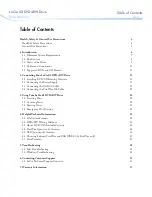
30
Assembly Instruction
Spindle Drive PLS
T
ROUBLSHOOTING
,
SERVICE
AND
REPAIR
M
AINTENANCE
AND
MODIFICATION
T
ROUBLSHOOTING
,
SERVICE
AND
REPAIR
Proper repair of a defective drive cannot be performed by the contractor
or end-user and is therefore not permissible. Repairs can only be carried
out by the manufacturer or by a specialist company authorized by the
manufacturer.
Unauthorized opening or manipulation of the drive causes loss of war-
ranty.
1. Exchange a faulty drive or have it repaired by the manufacturer.
2. If problems occur during installation or normal operation, use the
following table for troubleshooting.
Problem
Possible causes
Possible solutions
Drive does not
start
• Duration of mains
power supply too short
• Drive run direction not
correct
• Connecting cable not
connected
• Power supply / Control
Unit voltage incorrect,
too high or too low (see
data sheet)
• No mains supply to
power supply unit /
Control Unit
(no voltage)
• Drive has shut down
on overload
• Adjust supply voltage
as specifi ed in the
technical documen-
tation
• Check drive cables
change polarity
• Check all connection
cables
• Check power supply unit
and replace if necessary
• Connect power supply
• First move drive in
CLOSE position
Drive doesn‘t
start after
having been
in operation
several times
• Operating time has been
exceeded, drive has
been overheated
• See possible solutions
above associated with
„Drive doesn‘t start“
• Wait until drive has
cooled down and start
again
• See possible solutions
associated with:
“Drive doesn‘t start“
M
AINTENANCE
AND
MODIFICATION
Prior to any maintenance work or modifi cation of the system (e.g. exch-
ange of the drive) the mains voltage and – where available – the batte-
ries shall be disconnected in all poles and secured against unintended
operation (lock in separated position).
Lasting functionality and safety of the drive require maintenance by spe-
cialized staff at regular intervals (in the case of SHEV systems the legal
requirement is once a year). Check the system for operational availability
on a regular basis. This is also recommended for a system with purely
natural ventilation. At short intervals, check system for imbalance and
signs of wear or damage of cables, springs and fasteners.
Remove any contamination from the drive when servicing the system.
Check mountings and clamping screws for tight fi t. Test the devices by
opening and closing them in test runs.
The drive itself is maintenance-free.
Faulty devices may only be repaired in our plant. Only original parts from
the manufacturer may be used. If the mains cable is damaged it must be
replaced by the manufacturer or its service agent or a similarly qualifi ed
person in order to avoid hazards.
We recommend a scheduled Maintenance Agreement.
When cleaning the window, make sure that no water or cleaning agents
reach the drives.
Protect the drives from dirt and dust during construction phase.
1.
Drive / open the power-operated casement to its full opening width
(SHEV or ventilation angle).
2.
Disconnect the system from the power supply, deactivate batteries,
where appropriate, and secure against automatic or manual release.
3.
Inspect window and fi ttings for any damage.
4.
Check all mechanical fi xings (observe torque specifi cations in the
assembly instruction).
5.
Check electric drives for any damage and dirt.
6.
Check connections cables (drive cables) for
- tightness of cable gland
- operability of strain relief
- damages
7.
Check smooth movement of the hinges and fi ttings and re-adjust, if
necessary, or apply lubricants such as silicone spray (adhere to the
specifi cations of the window system manufacturer).
8.
Inspect / check seals (all the way round) and, if necessary, remove
contaminations or replace.
9.
Maintain the system (e.g. wipe with a wet cloth the opening element
of the drive „chain“ or „spindle“ using non-acidic / lye containing
agents and dry with a dry cloth and - if necessary lubricate with
cleaning oil (e.g. Ballistol)).
10.
Re-connect to power supply.
11.
Open and close power-operated window using the hand-held control
(function test).
12.
Check safeguards for fi nger protection and re-adjust, if necessary).
13.
Check that CE-label is attached to the power-operated element, e.g.
NSHEV.
14.
Check that warning notes and label on the drive are available.
15.
If required, carry out a risk assessment according to Machinery
Directive 2006/42/EC
(for example if the machine has been modifi ed).
Take all safety-related measures
required during servicing, in particular protective measu-
res against falling, fi nger crushing and safe access to the
work place.
!
07







































